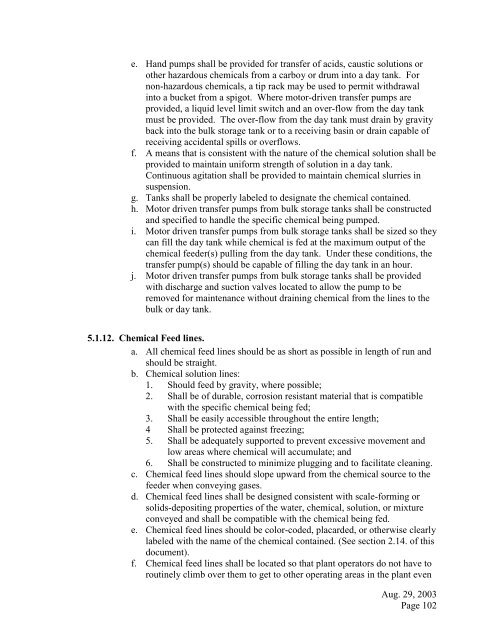Design Guide for Community Water Systems - The Water, Sanitation ...
Design Guide for Community Water Systems - The Water, Sanitation ...
Design Guide for Community Water Systems - The Water, Sanitation ...
Create successful ePaper yourself
Turn your PDF publications into a flip-book with our unique Google optimized e-Paper software.
e. Hand pumps shall be provided <strong>for</strong> transfer of acids, caustic solutions orother hazardous chemicals from a carboy or drum into a day tank. Fornon-hazardous chemicals, a tip rack may be used to permit withdrawalinto a bucket from a spigot. Where motor-driven transfer pumps areprovided, a liquid level limit switch and an over-flow from the day tankmust be provided. <strong>The</strong> over-flow from the day tank must drain by gravityback into the bulk storage tank or to a receiving basin or drain capable ofreceiving accidental spills or overflows.f. A means that is consistent with the nature of the chemical solution shall beprovided to maintain uni<strong>for</strong>m strength of solution in a day tank.Continuous agitation shall be provided to maintain chemical slurries insuspension.g. Tanks shall be properly labeled to designate the chemical contained.h. Motor driven transfer pumps from bulk storage tanks shall be constructedand specified to handle the specific chemical being pumped.i. Motor driven transfer pumps from bulk storage tanks shall be sized so theycan fill the day tank while chemical is fed at the maximum output of thechemical feeder(s) pulling from the day tank. Under these conditions, thetransfer pump(s) should be capable of filling the day tank in an hour.j. Motor driven transfer pumps from bulk storage tanks shall be providedwith discharge and suction valves located to allow the pump to beremoved <strong>for</strong> maintenance without draining chemical from the lines to thebulk or day tank.5.1.12. Chemical Feed lines.a. All chemical feed lines should be as short as possible in length of run andshould be straight.b. Chemical solution lines:1. Should feed by gravity, where possible;2. Shall be of durable, corrosion resistant material that is compatiblewith the specific chemical being fed;3. Shall be easily accessible throughout the entire length;4 Shall be protected against freezing;5. Shall be adequately supported to prevent excessive movement andlow areas where chemical will accumulate; and6. Shall be constructed to minimize plugging and to facilitate cleaning.c. Chemical feed lines should slope upward from the chemical source to thefeeder when conveying gases.d. Chemical feed lines shall be designed consistent with scale-<strong>for</strong>ming orsolids-depositing properties of the water, chemical, solution, or mixtureconveyed and shall be compatible with the chemical being fed.e. Chemical feed lines should be color-coded, placarded, or otherwise clearlylabeled with the name of the chemical contained. (See section 2.14. of thisdocument).f. Chemical feed lines shall be located so that plant operators do not have toroutinely climb over them to get to other operating areas in the plant evenAug. 29, 2003Page 102
















